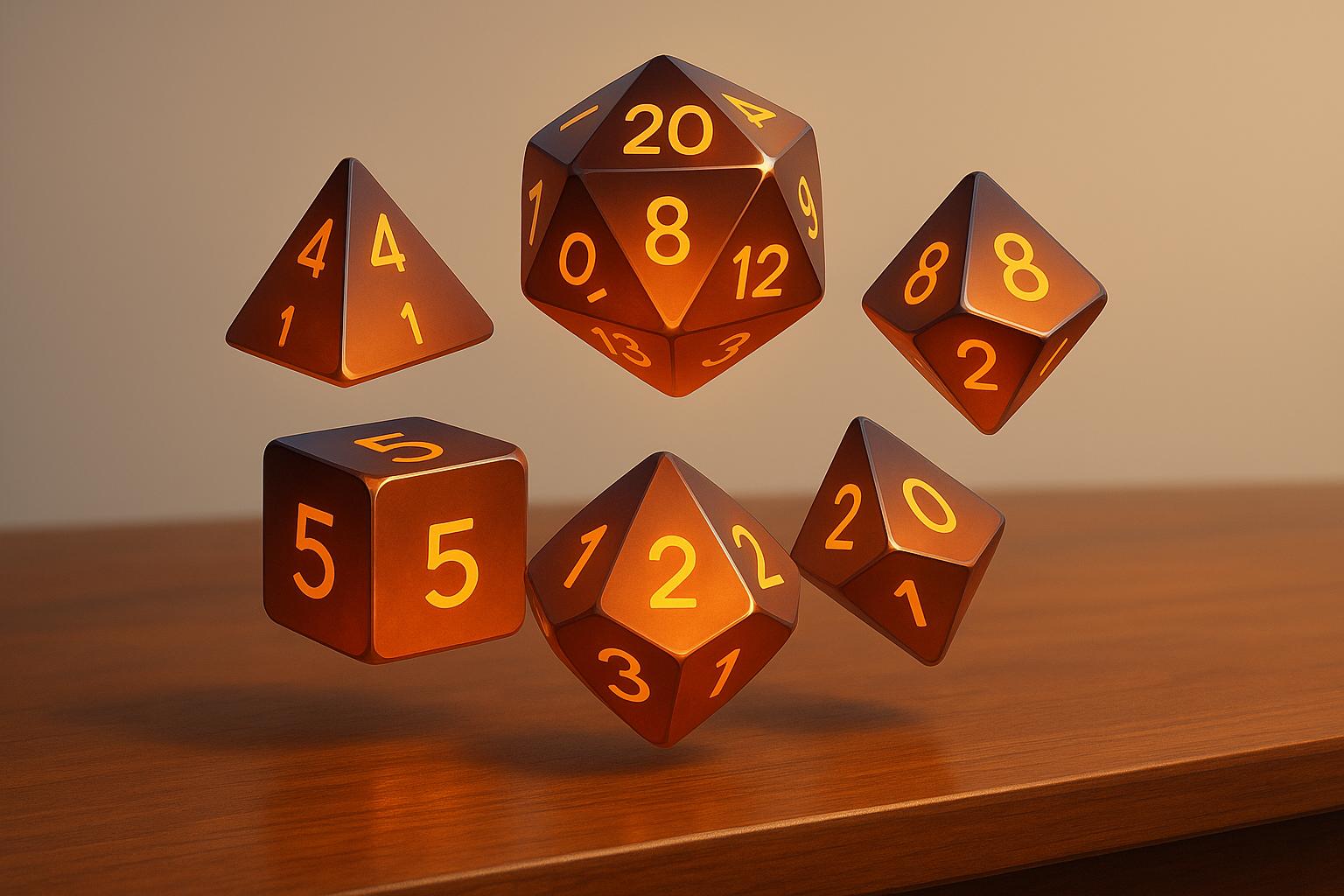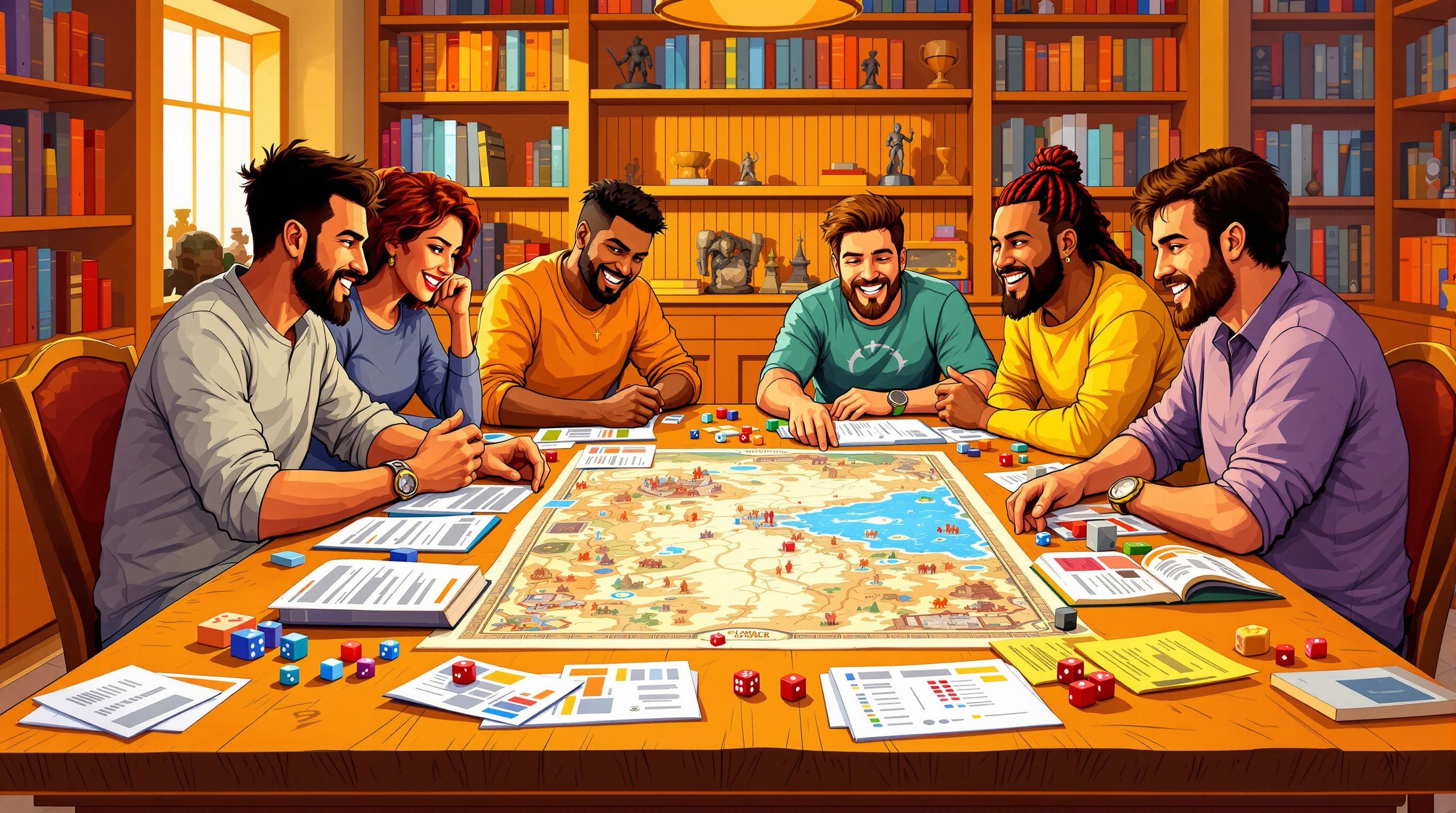Balancing storytelling and mechanics in tabletop RPGs can be tough, but it’s key to creating an engaging experience. Here’s a quick guide to mastering this balance:
- Blend story and mechanics: Tie game rules to narrative elements like character motivations or world-building.
- Use combat to advance the plot: Design battles with stakes that matter to the story and characters.
- Connect progression to decisions: Let character growth reflect narrative choices and priorities.
- Pace sessions effectively: Balance storytelling, combat, and exploration for smooth gameplay.
- Test custom rules: Ensure new mechanics enhance both the story and gameplay through structured playtesting.
The Secret to Balancing Combat and Story in D&D
Story and Mechanics: Core Functions
Game rules and storylines need to work together to keep players invested. The sections below explain how these elements shape both challenges and emotional connections in gameplay.
Game Rules and Player Challenge
Game mechanics set the stage for how players interact with the game world. When rules provide clear outcomes, balanced choices, consistent difficulty, and resource management, they enhance strategic gameplay. For example, in combat, well-defined rules for attacks, damage, and positioning make each move feel deliberate and impactful.
Key mechanical elements include:
- Clear resolution systems: Ensure players understand how their actions affect outcomes.
- Balanced character options: Provide fairness and variety in gameplay choices.
- Consistent challenge ratings: Maintain a steady level of difficulty to keep players engaged.
- Resource management systems: Encourage thoughtful decision-making by limiting what players can carry or use.
Mechanics tied to the story can create tension. For instance, a limited inventory forces players to decide what their characters truly value, adding weight to their choices.
Storytelling and Player Connection
While solid mechanics encourage strategic thinking, a strong narrative builds emotional engagement. Story elements give context to the mechanics and make game events more meaningful.
Key narrative components include:
- Character motivations: Shape mechanical decisions based on personal goals or backstory.
- Narrative consequences: Tie game actions to meaningful outcomes in the story.
- World-building: Use the story to explain and ground game mechanics.
- Environmental storytelling: Let the world itself tell a story through how players interact with it.
When a game blends mechanics with narrative, it creates a deeper experience. For example, a paladin's divine smite isn’t just a way to deal extra damage - it reflects their connection to their deity and their sworn oaths. Similarly, a skill check can become a high-stakes moment, and combat can feel like a dramatic showdown where every tactical choice reflects the character's personality and values.
The best sessions happen when rules and story come together seamlessly, turning gameplay into both a strategic challenge and an emotional journey.
Adding Story to Game Mechanics
A well-crafted RPG weaves mechanics and story together seamlessly. Here's how to embed narrative directly into your rules, transforming them into tools that drive both gameplay and plot.
Moving the Story Through Game Rules
Game mechanics can do more than resolve actions - they can push the story forward. For example, instead of generic Perception checks, tie rolls to uncovering critical details, like an NPC's hidden agenda or a villain's next move.
Here are a few ways to connect mechanics to the narrative:
- Skill Challenges: Use skill checks as part of story arcs. For instance, an Athletics check could represent a desperate dash to save a captured ally.
- Resource Management: Link inventory decisions or spell usage to story moments, reflecting character choices or plot twists.
- Investigation Mechanics: Make knowledge checks pivotal to revealing essential information that shifts the story’s course.
Even combat can be more than just a resource drain - it can become a pivotal part of the narrative.
Making Combat Matter to the Story
Combat encounters don’t have to exist in isolation. They can - and should - carry weight in the story. Design battles with stakes that matter to the characters and the plot.
Consider these ideas:
- Environmental Storytelling: Use battle locations to reveal details about the world or story, like ruins that hint at forgotten history.
- Character-Driven Objectives: Set goals that go beyond defeating enemies, such as saving innocents or stopping a dangerous ritual.
- Consequence-Based Outcomes: Let the results of combat influence the story, whether through enemy reactions or new revelations.
Here’s how some combat mechanics can tie directly into the narrative:
| Mechanical Element | Story Integration |
|---|---|
| Initiative Order | Reflect character priorities or motives |
| Damage Types | Connect to character backstories or themes |
| Terrain Features | Use the environment to tell a story |
| Victory Conditions | Align with objectives beyond simple survival |
Every dice roll has the potential to move your story forward. By blending mechanics with narrative, you create deeper character arcs and encounters that feel meaningful and engaging.
Character Growth Through Game Rules
Character growth in games happens through a mix of narrative decisions and mechanical progression. Well-designed game mechanics can effectively highlight a character's evolution and personality.
Player Choices and Character Actions
Game mechanics like skills, class features, resource management, and combat strategies can reflect a character's journey. These mechanics allow players to make decisions that deepen both storytelling and character development.
| Mechanical Element | How It Reflects Character Growth |
|---|---|
| Skill Proficiencies | Show expertise in areas aligned with character goals |
| Class Features | Mark key milestones in a character's story arc |
| Resource Management | Reveal priorities and decision-making styles |
For example, a player deciding to spend experience points on combat skills versus social abilities highlights their character’s focus and priorities. Similarly, how they manage limited resources like spell slots or action points can illustrate their character's values and approach to challenges.
Hard Choices Within Game Rules
Game rules should encourage players to make decisions that affect both gameplay and the story. These meaningful choices create opportunities for characters to grow by facing consequences.
Here are some ways to design impactful decisions:
- Resource Trade-offs: Force players to choose between immediate gains and future benefits.
- Ethical Dilemmas: Tie moral decisions directly to game mechanics, influencing outcomes.
- Relationship Systems: Introduce rewards or penalties based on character interactions and connections.
- Specialization Costs: Require sacrifices in other areas when advancing specific skills.
The goal is to ensure these choices feel connected to the character's journey, not just as a way to gain tactical advantages. When players must balance mechanical benefits against their character's beliefs or goals, it creates memorable moments of growth and reflection.
Mechanical progression should feel like something earned through gameplay, not handed out arbitrarily. This strengthens the bond between the rules and the character's story, making the experience more rewarding for everyone involved.
sbb-itb-b8b00a5
Setting the Right Game Speed
Balancing storytelling with game mechanics is key to keeping players engaged. The trick is to maintain momentum while giving both the narrative and the rules their time to shine.
Mixing Story and Game Rules
Smoothly transitioning between story moments and mechanical challenges creates a rhythm that matches your group's preferences and the current story arc.
| Session Element | Optimal Duration | Purpose |
|---|---|---|
| Story Scenes | 15–20 minutes | Develop characters and advance the plot |
| Combat Encounters | 30–45 minutes | Provide tactical challenges and engage with mechanics |
| Social Interactions | 10–15 minutes | Build the world and relationships |
| Exploration | 20–30 minutes | Encourage discovery and environmental storytelling |
To keep the pace engaging:
- Begin major story beats with character-driven moments.
- Introduce mechanical challenges that naturally flow from the story.
- Allow downtime after intense combat for reflection and plot development.
- Use quick skill checks or brief combats to maintain energy during story-focused segments.
Once you’ve established this balance, tailor encounters to fit your group’s unique playstyle.
Making Encounters Fit Your Group
Every group is different, with varying preferences for challenge and engagement. Pay attention to player feedback and adjust your approach accordingly.
When designing encounters, consider:
- Player Experience Level: Match the complexity of mechanics to your group’s familiarity with the rules.
- Story Significance: Adjust the difficulty of challenges based on their narrative weight.
- Session Length: Plan the number of encounters to fit the available playtime.
Here’s a framework to help structure combat encounters:
| Encounter Type | Story Impact | Mechanical Challenge |
|---|---|---|
| Minor Conflicts | Low stakes, quick resolution | Simple tactical decisions |
| Story Battles | Key character moments | Moderate complexity |
| Climactic Fights | Major plot resolutions | Full mechanical depth |
Not every conflict needs to be resolved with combat. Mix in skill challenges, social encounters, or environmental puzzles to keep gameplay varied and engaging. This prevents any single aspect of the game from feeling repetitive.
When adjusting difficulty, focus on making challenges meaningful to the story. The best encounters advance the narrative while offering players interesting ways to interact with the game mechanics.
Testing Custom Game Rules
Testing custom rules helps refine storytelling and game mechanics while keeping everything balanced. This phase ensures that your narrative-driven mechanics work smoothly and remain engaging.
Checking Rule Changes
Before making new rules permanent, test them in focused sessions. Use a structured approach to assess their effects:
| Testing Phase | Duration | Focus Areas |
|---|---|---|
| Initial Playtest | 2-3 sessions | Basic functionality and story integration |
| Extended Trial | 4-6 sessions | Long-term impact on story flow |
| Final Review | 1-2 sessions | Fine-tuning and balance adjustments |
When reviewing custom rules, focus on these key points:
- Story Integration: Does the rule fit naturally within the story?
- Mechanical Balance: How does it affect existing systems and player decisions?
- Table Flow: Does it keep gameplay smooth without constant rule-checking?
- Player Engagement: Does it make players more invested in both the story and tactical moments?
Track both mechanical effects (e.g., average combat duration, damage output) and storytelling outcomes (e.g., character development, dramatic moments).
Getting Player Input
Once you've tested rule changes, gather feedback from players to fine-tune your approach. Use structured feedback methods to capture both immediate impressions and longer-term insights.
Plan feedback sessions around these timings:
| Feedback Type | Timing | Purpose |
|---|---|---|
| Quick Check | End of session | Capture immediate reactions |
| Detailed Review | After 3 sessions | Evaluate the rule's overall impact |
| Group Discussion | Monthly | Refine rules collaboratively |
When collecting feedback, focus on these areas:
- Mechanical Impact: How does the rule affect tactical decisions?
- Narrative Enhancement: Does it create meaningful story moments?
- Ease of Use: Is the rule clear and easy to apply during gameplay?
- Overall Enjoyment: Does it improve the gaming experience?
Introduce one major change at a time. Testing multiple changes at once can make it harder to pinpoint what works and what needs adjustment. Keep detailed notes on player reactions and observed effects to guide future tweaks.
If a custom rule works well, document it clearly and share it with your group. Consider creating a simple reference guide that explains how the rule works mechanically and its intended impact on the story.
Conclusion
Finding the right balance between story and mechanics in tabletop RPGs requires careful attention to both aspects. By thoughtfully blending narrative elements with game systems, you can create unforgettable experiences that cater to both tactical and storytelling preferences.
Here’s a quick look at key strategies to refine your game:
| Focus Area | Strategy | Expected Outcome |
|---|---|---|
| Rule Testing | Run 2-3 session trials | Gain clarity on how mechanics function |
| Story Integration | Tie character abilities to plot points | Encourage deeper player engagement |
| Player Feedback | Hold monthly group discussions | Continuously improve game balance |
Every group is different, and understanding their preferences is crucial. Some might enjoy a 60/40 split favoring mechanics, while others lean more toward story-driven sessions. Once you find the right mix, aim to maintain consistency.
A good starting point? Combine one mechanical feature with a story-driven moment and adjust based on how your players react. This step-by-step method helps lay the groundwork for a well-balanced campaign.
For game masters aiming to take their campaigns to the next level, the TTRPG Games Directory is a great resource. It offers insights into various game systems and how they approach the balance between narrative and mechanics. This can help you choose mechanics that enhance your storytelling while keeping gameplay engaging.
Ultimately, successful campaigns rely on ongoing adjustments and open communication. This creates an immersive, rewarding experience that keeps players coming back for more.
FAQs
How can I combine storytelling and game mechanics in RPGs without disrupting the flow of gameplay?
To seamlessly integrate storytelling with game mechanics in tabletop RPGs, focus on creating synergy between the two. Start by aligning the mechanics with the themes and tone of your narrative. For example, if your story emphasizes character development, use mechanics that reward role-playing and emotional choices. Similarly, if the story is action-oriented, ensure the combat system is engaging and fits the pacing of the narrative.
Another key strategy is to allow flexibility. Game mechanics should serve as a framework, not a restriction. Be open to adjusting rules when they hinder storytelling or break immersion. Encourage collaboration between players and the game master (GM) to maintain a balance that prioritizes both the story and the gameplay experience.
Lastly, consider exploring resources like detailed game directories to find RPG systems that naturally blend strong storytelling and mechanics. This can help you choose a system tailored to your group's preferences, ensuring a smoother integration from the start.
How can I make combat encounters more engaging and meaningful in my RPG sessions?
To create meaningful and engaging combat encounters in your RPG sessions, tie them directly to the story and characters. Each battle should feel like a natural extension of the narrative, whether it’s advancing a plotline, revealing a character’s backstory, or exploring the world’s setting.
Vary the objectives of your encounters to keep them fresh and exciting. Instead of always focusing on defeating enemies, consider goals like protecting a key character, retrieving a critical item, or escaping a dangerous situation. You can also use combat as an opportunity to unveil important story details, such as enemy motivations, hidden alliances, or unexpected twists.
Lastly, ensure the difficulty of each encounter aligns with the pacing of your story and the players’ progress. Challenges should feel rewarding without overwhelming the group, striking a balance between tension and fun.
How do I balance player feedback with my creative vision when testing custom RPG rules?
Balancing player feedback with your creative vision requires finding a middle ground that respects both perspectives. Start by listening closely to your players' experiences and identifying patterns in their feedback. This can help you understand what aspects of your rules enhance or hinder gameplay.
At the same time, stay true to the core themes and mechanics you want to highlight in your game. Focus on adjustments that improve the experience without compromising your original goals. Remember, collaboration often leads to a richer and more enjoyable game for everyone involved.


